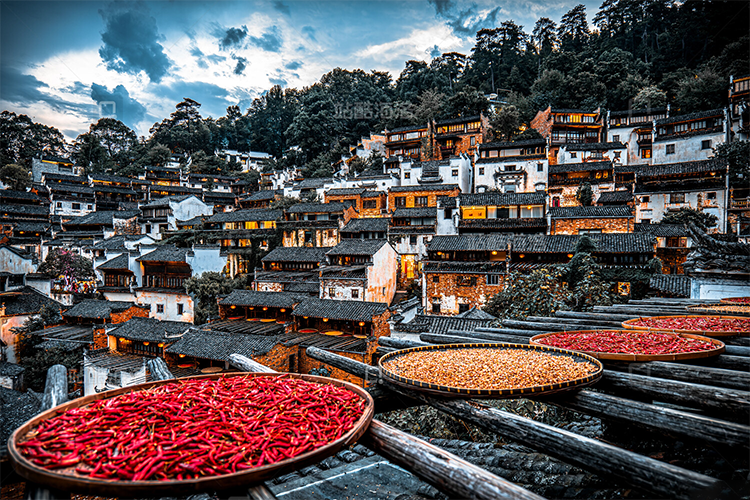Discover Wuyuan Rapeseed Flowers at Huangling’s Sky Terraces
Introduction
The first morning light slips through mountain mists and spills across layered terraces, waking the roofs of hundreds of white-walled, black-tiled Hui houses. Bright red chilies in bamboo trays, golden corn, and orange chrysanthemums spread over dark eaves like a painter’s palette. This is Huangling in Wuyuan, Jiangxi — a “sky city” hanging on a 600-meter cliff, where Ming–Qing villages meet vast terraced fields and a living sun-drying tradition (shaiqiu) that has become one of China’s most photogenic rural symbols.
1. Soul Imprint: Why Huangling Is Irreplaceable
“Terrace homes and the kingdom of sun-drying” — this phrase captures Huangling’s essence. As a model of Hui culture and nature in harmony, Huangling is a national 4A scenic area and a magnet for photographers and cultural travelers. Its unique appeal comes from three intertwined features: the only large-scale, living sun-drying tradition (protected as intangible cultural heritage), thousand-acre terraced rapeseed fields that rank among China’s largest, and a cliffside ensemble of Ming–Qing Hui architecture that reads like an open-air museum.
2. Decoding Sun-Drying: An Agricultural Epic on Rooftops
Sun-drying here is far more than a farm chore — it’s a clever adaptation to steep terrain and a cultural performance. With virtually no flat land, villagers set bamboo racks (bian) on extended eaves to dry harvests, gradually shaping a distinctive visual culture.
– Best viewing period: Mid-September to early December; colors peak after the first frost. Observe full sun-drying work on-site before 9:00 a.m. daily.
– Photo tips: The Wuguitang viewing platform offers panoramic shots; the Sun-Drying Workshop (Shai Gongfang) allows close-up details. After rain, fog threading through drying trays creates otherworldly images.
– Cultural meaning: Dominant red and yellow tones symbolize abundance and good fortune. After harvest villagers sometimes arrange crops into characters such as “fu” (good luck) or “xi” (double happiness), expressing gratitude to nature.

3. Seasonal Variations: From Rape Blossoms to Golden Rice Waves
Huangling’s terraces change wardrobe with the seasons:
– Spring (Mar–Apr): Tens of thousands of acres of rapeseed flow down the hills like a golden waterfall against white walls and dark tiles. For misty sunrise shots, arrive at Leixin Bridge before 6:00 a.m.
– Summer (May–Aug): Green rice terraces climb toward the clouds; after rain the village often disappears under a sea of mist.
– Autumn (Sep–Nov): Ripe rice and sun-drying arrays perform together; late October enhances depth when ginkgo turns yellow.
– Winter (Dec–Feb): Snow over Hui architecture reduces the scene to monochrome; hanging chilies provide striking color accents.
4. Cliffside Village: A Walking Textbook of Hui Architecture
Huangling’s “Tianjie Nine Lanes” winds along the cliff with more than 60 preserved Ming–Qing structures, showcasing Hui architectural masterpieces:
– Brick carving: Doorway reliefs depict motifs like “Qilin with child” or scenes of rural life, reflecting Confucian themes.
– Timber structure: The Cao Clan Ancestral Hall features a winter-melon beam spanning nine meters — no nails were used, yet it has stood for 400 years.
– Fengshui layout: The village alignment follows a Big Dipper-like pattern and still uses original drainage systems.
Must-visit spots:
– Yixin Tower: A former merchant residence whose second-floor balcony overlooks Tianjie.
– The Upside-down House: A playful attraction that feels like “walking on eaves.”
– Shuhe Hall: A 300-year-old red-wood cedar living with adjacent dwellings — a rare coexistence of tree and house.

5. Ultimate Experiences: Ways to Play Huangling
– Skywalk and cableway: Leixin Bridge’s 120-meter glass boardwalk floats above the flower sea; cable cars have panoramic skylights.
– Hands-on crafts: Learn to make steamed rice cakes (qi gao) in the Sun-Drying Grandma Canteen, try pounding sticky rice cakes (mochi-like) or making oil-paper umbrellas.
– Night visits: Tianjie lit at dusk looks like a poured galaxy; the Magic Forest 3D light show is highly recommended.
6. Practical Guide: Transport, Tickets, and Accommodation
– Getting there:
– By car: A 40-minute drive from Wuyuan county seat; mountain roads are narrow and winding — drive cautiously.
– By bus: Direct shuttle buses run from Wuyuan High-Speed Rail Station (about 1 hour, ticket roughly 20 RMB).
– Tickets: 145 RMB (includes round-trip cableway). Park hours: 7:30–17:30. Plan 4–6 hours for a standard visit.
– Where to stay:
– Tianjie Hotel: Rooms open onto sun-drying views; book up to three months in advance during peak flower seasons.
– Xiaoyun Village (foothill homestays): Better value; many guesthouses offer pickup and drop-off services.

Conclusion
Huangling’s beauty is the everyday enthusiasm seen in chilies and corn drying under eaves, the spring-scented mud churned by oxen through rapeseed blooms, and six centuries of merchant tales echoing on Tianjie’s stone slabs. This is not a staged theme park but a living, breathing Chinese village. Stand on Leixin Bridge and watch smoke rise from a sun-drying home’s horse-head wall, and you’ll understand — some views are worth crossing mountains to meet.
(Approximately 1580 Chinese characters equivalent)


